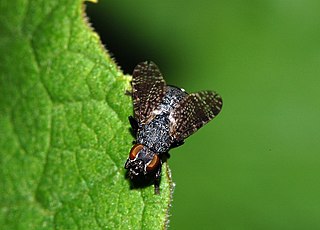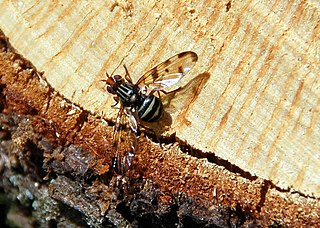
The Ulidiidae or picture-winged flies are a large and diverse cosmopolitan family of flies (Diptera), and as in related families, most species are herbivorous or detritivorous. They are often known as picture-winged flies, along with members of other families in the superfamily Tephritoidea that have patterns of bands or spots on the wings. Some species share with the Tephritidae an unusual elongated posteroapical projection of the anal cell in the wing, but can be differentiated by the smoothly curving subcostal vein. Two species, Tetanops myopaeformis and Euxesta stigmatias, are agricultural pests.

The Tephritoidea are a superfamily of flies. It has over 7,800 species, the majority of them in family Tephritidae.

The Micropezidae are a moderate-sized family of acalyptrate muscoid flies in the insect order Diptera, comprising about 500 species in about 50 genera and five subfamilies worldwide,. They are most diverse in tropical and subtropical habitats, especially in the Neotropical Region.

Canacidae, incorrectly Canaceidae, or beach flies, surf or surge flies, is a family of Diptera. As of 2010, 307 species in 27 genera. The family now includes Tethininae as a subfamily.

Clusiidae or "druid flies" is a family of small, thin, yellow to black acalyptrate flies with a characteristic antenna and with the wing usually partially infuscated. They have a cylindrical body. The head is round, the vertical plate reaches the anterior margin of the frons and the vibrissae on the head are large. The costa is interrupted near subcosta and the latter developed throughout length. Larvae are found in the bark of trees, the flies on trunks. The larvae are notable for their ability to jump. Males of many species in the subfamily Clusiodinae have been observed while engaged in lekking behaviour. There are hundreds of species in 14 genera found in all the Ecoregions, although most species occur in tropical regions. The type genus is Clusia Haliday, 1838.

The Platystomatidae are a distinctive family of flies (Diptera) in the superfamily Tephritoidea.

The Helosciomyzidae are a small family of flies found exclusively in the Southern Hemisphere. With the exception of the South American genus Sciogriphoneura, helosciomyzids occur only in Australia and New Zealand.

Otitinae is the name of a subfamily of flies in the family Ulidiidae. It was formerly the Otitidae. Like the Ulidiinae, most species are herbivorous or saprophagous. Most species share with the Tephritidae an unusual elongated projection of the anal cell in the wing, but can be differentiated by the smoothly curving subcostal vein. Most are dull gray to shiny brown or black flies with vein R1 setulose or, in a few cases, bare.

Platystomatinae is a subfamily of flies (Diptera) in the family Platystomatidae that includes 80 genera, the largest subfamily with at last estimate, c. 900 species globally.

Tethininae, formally the family Tethinidae is a paraphyletic group of tiny drab-coloured or grey Acalyptratae flies. There are over 115 species in 7 genera known from all zoogeographic regions. They are inconspicuous flies which are still poorly known in some remote, huge, tropical areas.

Tetanocera is a genus of marsh flies, insects in the family Sciomyzidae. There are at least 50 described species in Tetanocera.

Myennidini is a tribe of picture-winged flies in the family Ulidiidae.

Pogonortalis doclea, the boatman fly, is a species of signal fly. It is native to Australia and has been introduced to California in the United States.

Plastotephritinae is a subfamily of flies (Diptera) in the family Platystomatidae, which currently includes 18 genera.
Scholastinae is a subfamily of flies (Diptera) in the family Platystomatidae, which currently includes 14 genera.

Oeciotypa is a genus of flies (Diptera) belonging to the family Platystomatidae.

Cephaliini is a tribe of picture-winged flies in the family Ulidiidae.
Neoardelio is a genus of signal flies in the family Platystomatidae endemic to southern Africa.












